-
পরবাস
বাংলা ভাষা, সাহিত্য ও সংস্কৃতি
Parabaas, a Bengali webzine since 1997 ... ISSN 1563-8685 -
ছোটদের পরবাস
Satyajit Ray
Rabindranath Tagore
Buddhadeva Bose
Jibanananda Das
Shakti Chattopadhyay
সাক্ষাৎকার -
English
Written in English
Book Reviews
Memoirs
Essays
Translated into English
Stories
Poems
Essays
Memoirs
Novels
Plays
-

Buy in India and USA
-

Audiobook
Looking For An Address
Nabaneeta Dev Sen
Available on Amazon, Spotify, Google Play, Apple Books and other platforms.
-

Cautionary Tales
BookLife Editor's Pick -

পরবাস গল্প সংকলন-
নির্বাচন ও সম্পাদনা:
সিদ্ধার্থ মুখোপাধ্যায়)
-

Parabaas : পরবাস : বাংলা ভাষা, সাহিত্য ও সংস্কৃতি -
পরবাস | Satyajit Ray | Book-Review
Share -
Divergent Rays : Susan Chacko
The Adventures of Feluda, by Satyajit Ray; Translated by Chitrita Banerjee; Penguin, India; 1988; (First Published in Bengali by Ananda Publishers, 1971-1981); 267 Pages; ISBN:0-14-011221-9
Childhood Days: A Memoir, Translated by Bijoya Ray; Penguin, Inida; 1998; (first appeared serially in Sandesh in 1980, 81. First published in book form in Bengali by Ananda Publishers, Calcutta, 1982. Ekei Bole Shooting (`Making Movies') was first published in Bengali by Neuscript, Calcutta, 1979) 173 Pages; ISBN: 0-14-025079-4


Some might think that a mystery is a mystery, and what difference does it make if the hero goes to Jaipur or the Cornwall coast? It does, though. There's a spark of pleasurable familiarity in stories that are set in places that one knows, and mysteries that are solved by people who eat alu sabji instead of licorice. Ideally, the locale should be deeply woven into the plot itself, and the Feluda stories certainly live up to this ideal, as when the burglar in Mystery at Golok Lodge counts on the daily load-shedding to cover his escape.
For those who have yet to make his acquaintance, Feluda is properly known as Prodosh Mitter, who lives in Calcutta. He is a private investigator in the Holmes style, taking up only interesting cases and willing to put both physical and mental energy into solving them. He is assisted by his 14-year-old cousin, Tapesh (aka Topshe) an able lieutenant who records the cases and picks up useful snippets of Feluda's methods on the way. The two are also accompanied by Lalmohan Ganguly, an enthusiastic and cheerful companion who writes potboiler thrillers under the name of Jatayu.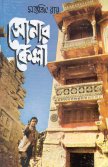
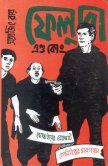

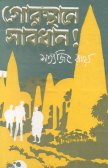
In the foreword to the book, Ray says that he loved the Sherlock Holmes stories as a child, and the structure of the Feluda stories is very similar. They were originally written in Bengali for Sandesh, the children's magazine that his grandfather started in 1913. Each story starts with Feluda and Topshe at home, a client arrives and frames the mystery, and the trio set off on their adventures. Feluda is a Holmesian combination of mental and physical agility -- almost 6 feet tall, he is in fine shape due to his early-morning yoga -- and all his skills are called upon during the course of the story.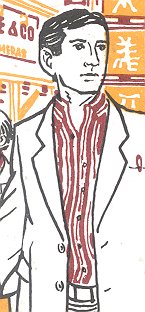


Feluda, Jatayu, Topshe
Illustrations by Satyajit
The Golden Fortress is the story in which Feluda and Topshe meet Jatayu. The client in this story is the father of 10-year-old Mukul, who has started having vivid dreams of what is presumed to be a past life. The dreams involve the fort of the title, and contain many details about peacocks and sand, none of which the child has ever seen. A 'parapsychologist' takes the boy off to Rajasthan, hoping to pump his memories for hidden treasure. But nefarious scoundrels are also on the trail of this treasure -- will Feluda and co. get there in time?
Of course they will. The pleasure of such books lies in knowing that Feluda will undoubtedly outwit the crooks, but the reader can exercise his or her own brain in discovering their identities.
Unlike many modern thrillers, the Feluda stories are not at all gruesome. People are captured or tied up or even beaten up, but the reader is not assailed by blood and gore (as, quite likely, he would be if he read Jatayu's thrillers!). Sensitive children will not get nightmares after these books, but they are no less delightful for the lack of exploding eyeballs.
From an adult perspective, one of the charms of the Feluda stories is the sly commentary sprinkled throughout, which undoubtedly reflect the author's opinions:
(walkiing along Marine Drive in Bombay) "I am sure there is no Municipal Development Authority here, as in Calcutta." "Why, because the roads have no potholes?"
And the most entertaining, where Feluda describes a typical Hindi movie:
(from The Buccaneer of Bombay)
"I discovered today that those two cuttings in his wallet were cut out with a blade from newspapers nearly two centuries old which have been carefully preserved in the National Library Reading room. In my opinion, a man should go to prison for this."
(from Trouble in the Graveyard)It should take an hour-and-a-half to build up the story, and another hour-and-a-half to unravel it.[...]You must have smuggling, gold, diamonds, marijuana, hashish, whatever; five songs, one of which should be devotional; two dance numbers; two or three chase sequences -- in at least one of which an expensive car should be seen rolling downhill; there must be one fire scene; the girlfriend of the hero must be the heroine and the girlfriend of the villain has to be the vamp; you need a conscientious police officer; some flashback scenes for the hero; comic relief and fast action so that the plot does not sag; if you can, shift the scene to the mountains or to the beach so that your stars don't have to keep on shooting in the cramped atmosphere of a studio. [..] And finally -- this is a must -- you have to have a happy ending. And if before that you can make the tears flow, then so much the better.
A fail-safe recipe, is it not?
Feluda's world is strange in one notable respect -- there are no women. He is entirely surrounded by men. He has no aunts or female cousins, as is common in large extended families. Every person he comes across on a bus or train is male, as is every person selling chappals on the roadside or eating in a train. There are little boys, but no little girls. One might think the author was uncomfortable with women characters, if this had not been the same person who created Charulata, Durga and Arati in his movies. Feluda's household arrangements are a little mysterious too -- there is an occasional mention of Topshe's father, who seems to live in the same house, but no other relatives seem to live there or run the household. Perhaps Satyajit Ray left these particular mysteries for his readers to solve.The translation is generally very smooth, but has an occasional oddity; for example 'There was a gas station nearby' on p 83. Gas station? Shouldn't that be petrol? As, indeed, it is in other places in the same novella.
The Feluda stories are charmingly modern, and don't read at all dated. Some other Bengali children's stories are much more traditional in form, so that you can see the stylistic parallels with classics like the Panchatantra and Jataka Tales. But Feluda, characteristic Charminar in mouth, lives in our own times.
 Childhood Days actually consists of two memoirs: Ray's reminiscences of his childhood occupy only the first half of the book. The second half, Making Movies, consists of fascinating stories of his movie-making experiences, and is, for this reader at least, by far the more interesting section.
Childhood Days actually consists of two memoirs: Ray's reminiscences of his childhood occupy only the first half of the book. The second half, Making Movies, consists of fascinating stories of his movie-making experiences, and is, for this reader at least, by far the more interesting section.
By his own account, Ray had a happy childhood surrounded by a large extended family. He has few memories of his father, who died young, but he does not seem to have felt a gap in his life. These memories were written for children, and are the sort of stories that an elderly uncle would tell about his childhood -- of the days when there were no ice cream carts on the street, there were large English stores in Calcutta, and lucky children entertained themselves with magic lantern slideshows. Ray came from a famous family, of course, and this affected him to the extent that he had to suffer some teasing about his important relatives in school. As with any large extended family, there were a few odd characters who make for good stories, such as Chhoto Kaka, the judo enthusiast. Mostly, though, Childhood Days is a factual account of various relatives who influenced his early childhood.
The net effect is strangely bland. During his holidays, he played with his cousins Nini, Ruby, Kalyan and Lota, and they were his good friends. But he doesn't tell us anything more about them -- did they gang up on one another? climb trees? play gilli-danda? Did they remain friends as they grew older? Did they even have distinct personalities? These anecdotes as sketched in the book are not terribly meaningful to those who've never met Nini, Ruby, Kalyan and Lota.
There is some historical context, but not much personal context. The Swadeshi movement is briefly mentioned; the main effect on Ray's life was that he learnt to spin, along with everyone else in his family. He mentions that his mother took a job at a school for widows, but doesn't say if this was unusual, if it was because his father had died and they were financially strapped, or how she felt about her job.
For an author whose own plots were clever and well-planned, the anecdotes in Childhood Days often lack context and completeness. An example: one of his schoolteachers was called on jury duty for the case of a zamindar's murder, whose death by poison injection had occurred at Howrah Station. "Each time Brojen Babu returned after a hearing, we badgered him for details. He, too, seemed perfectly willing to share his experiences with us". But what about the readers, who like me must have been dying to know what happened in the case, and if the murderer had been convicted? The anecdote ends right there, and the next paragraph is about school uniforms.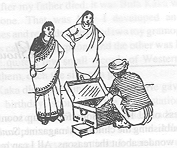 The most pleasure is to be obtained from the illustrations, by Ray himself. Here, finally, you get a hint of his versatility. One in particular, of his mother and aunt buying sweets from a boxwallah, shows his ability to capture personalities in his pencil sketches Even here, however, there is a lack of information; did he draw these as a child, or from memory as an adult?
The most pleasure is to be obtained from the illustrations, by Ray himself. Here, finally, you get a hint of his versatility. One in particular, of his mother and aunt buying sweets from a boxwallah, shows his ability to capture personalities in his pencil sketches Even here, however, there is a lack of information; did he draw these as a child, or from memory as an adult?
Many hands cooperated in the production of these memoirs. Ray wrote the serialized stories for Sandesh, but died before he could translate them himself, as he had wished. The childhood memoirs were then translated by his wife, Bijoya Ray, but her ill health precluded her from completing the task. The book was then extensively edited by Gopa Majumdar and Sudeshna Shome Ghosh. Perhaps the many cooks were responsible for the absence of any distinctive flavour.
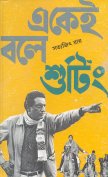 It is a pleasant relief to go on to Making Movies. The chapter 'Two and a half years with Apu', will of course, interest the many lovers of the Apu trilogy. Ray was working in an advertising agency during the filming of Pather Panchali, and could only film on holidays and weekends. They also ran out of money, so the film took over two years to make. This introduced its own complications -- the actors playing Apu and Durga were now two years older, and there was concern that their changing age would become obvious in the film. The crew had to deal with work around changes in seasonal vegetation and the unhelpful village dog. Their time, money and the appropriate weather rarely coincided, so that it took months before they could shoot the rain scenes. Given all the limitations, it is truly amazing that the final film is such an unalloyed delight.
It is a pleasant relief to go on to Making Movies. The chapter 'Two and a half years with Apu', will of course, interest the many lovers of the Apu trilogy. Ray was working in an advertising agency during the filming of Pather Panchali, and could only film on holidays and weekends. They also ran out of money, so the film took over two years to make. This introduced its own complications -- the actors playing Apu and Durga were now two years older, and there was concern that their changing age would become obvious in the film. The crew had to deal with work around changes in seasonal vegetation and the unhelpful village dog. Their time, money and the appropriate weather rarely coincided, so that it took months before they could shoot the rain scenes. Given all the limitations, it is truly amazing that the final film is such an unalloyed delight.
Many of the anecdotes deal with the difficulties of filming with animals -- the camels in Shonar Kella (The Golden Fortress), the dog in Pather Panchali, the tiger in Goopy Gyne Bagha Byne. The book ends (rather abruptly) with the successful shot of the Hirak Rajar Deshey scene in which Bagha has to steal the keys from above the tiger, while Goopy sings to keep the tiger motionless. If you want to know how it was done, read the book!
Published February 1, 2003 - এই লেখাটি পুরোনো ফরম্যাটে দেখুন
- মন্তব্য জমা দিন / Make a comment
- মন্তব্য পড়ুন / Read comments
- কীভাবে লেখা পাঠাবেন তা জানতে এখানে ক্লিক করুন | "পরবাস"-এ প্রকাশিত রচনার দায়িত্ব সংশ্লিষ্ট রচনাকারের/রচনাকারদের। "পরবাস"-এ বেরোনো কোনো লেখার মধ্যে দিয়ে যে মত প্রকাশ করা হয়েছে তা লেখকের/লেখকদের নিজস্ব। তজ্জনিত কোন ক্ষয়ক্ষতির জন্য "পরবাস"-এর প্রকাশক ও সম্পাদকরা দায়ী নন। | Email: parabaas@parabaas.com | Sign up for Parabaas updates | © 1997-2025 Parabaas Inc. All rights reserved. | About Us